All medium-sized and large pig abattoirs in Denmark use CO2 for stunning before killing © Danish Technological Institute
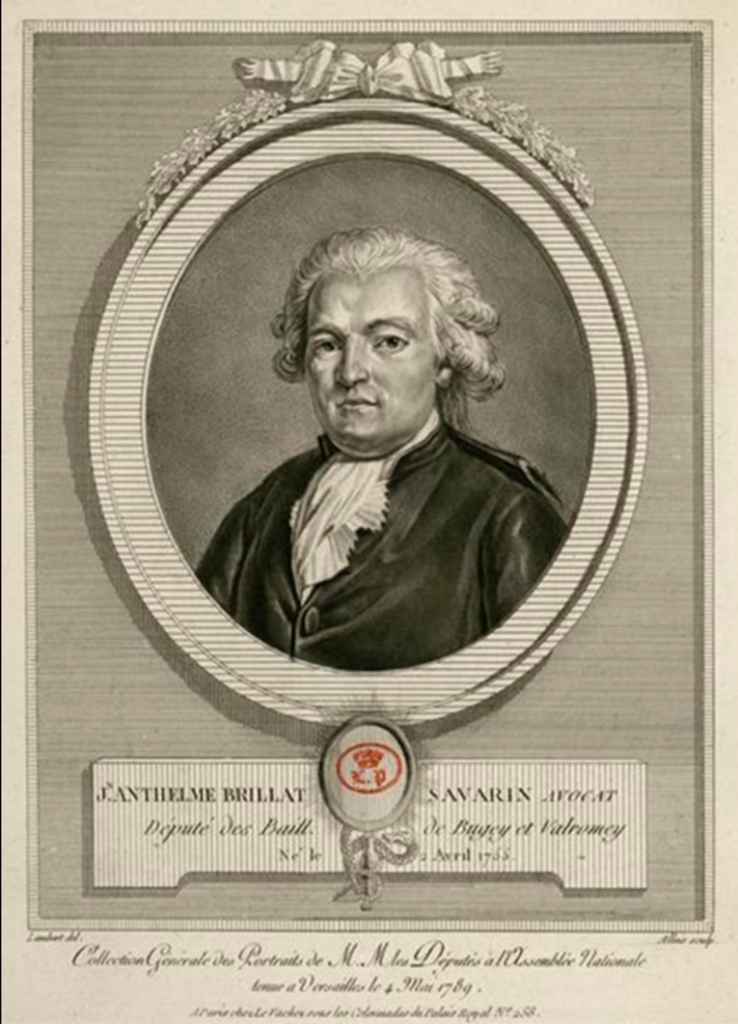
The phrase ‘you are what you eat’ was used as the title of a book by Doctor Gillian McKeith, published in 2005 to coincide with her programme of the same name on Britain’s Channel 4 television. It ran from 2004 to 2007 and promoted healthy eating. The phrase is said to have originated in the 1826 book, published in France under the title “Physiologie du Gout, ou Méditations de Gastronomie Transcendante” (Physiology of Taste, or Meditations of Transcendent Gastronomy) in which the author, Anthelme Brillat-Savarin, wrote: “Tell me what you eat and I will tell you what you are.” If so many people today just eat fast food delivered by young people on scooters or collected outside fast-food joints, what are we all?
In English, the word ‘burgher’ (with an ‘h’) used to mean a freeman or citizen of a borough, while the word ‘burger’, which is pronounced in the same way, means something that certainly wouldn’t taste the same, being – as my Chambers dictionary puts it – “a fried or grilled cake of meat, etc”. I imagine it’s the “etc.” that may cause some people to worry. But whatever kind the meat turns out to be, you may be concerned as to how it was killed. At least, you will be if you’re a devout Jew or a Muslim. And ensuring your meat is truly kosher or halal is not so easy in some parts of Europe.
The Jewish system for the ritual slaughter needed to produce kosher meat is called shechita and it must be carried out by a shochet, a specially trained and respected man (not a woman) from the Jewish community. When shechita is performed correctly, a shochet severs the animal’s carotid arteries and the jugular veins with a long knife that is surgically sharp and without imperfection – there must be no nicks or scratches on the blade – theoretically causing the animal to lose consciousness instantly through massive blood loss.
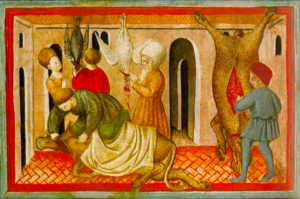
Both faiths say the slaughter is humane because the exsanguination is so fast. The system employed by Muslims is remarkably similar and must come from the same historic roots. It’s called dhabīḥah (pronounced “zabiha”) and the slaughterer must say “Bismillah” – in the name of Allah – over each beast as it is killed. In Sura 6 of the Qur’an, it is written “Eat of that over which God’s name has been mentioned, if you believe in his signs”. There are also strict rules about the type of meat and the method of killing. “Forbidden to you,” says Sura 5, “are carrion, blood, the flesh of swine, what has been hallowed to other than God, the beast killed by strangling, the beast killed with a violent blow, the beast fallen to death, the beast gored by some other animal’s horns, and that eaten by a wild beast, except those whom you slaughter; and that which is slaughtered at the altar and that which is distributed by the throwing of arrows [for foretelling the future]; this is an act of sin.” It’s the ban on killing with “a violent blow” that is seen by some as barring the use of pre-stunning, the supposedly humane method of making the slaughter as painless as possible
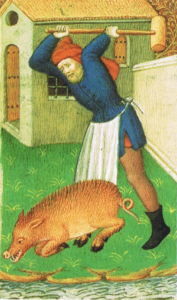
Laws governing ritual killing vary considerably. It’s so complicated that the Library of Congress (LOC) has a long article about it on its ‘Law.gov’ page, which is very helpful, if slightly out of date now: “Several European countries do not allow derogations from the general requirement of prior stunning,” it informs us. “These include Sweden, Norway, Iceland, Denmark, and Slovenia. Switzerland and Lichtenstein require prior stunning except for poultry. Finland requires concurrent sedation (normally stunning as the knife is applied); legislation is pending that would require prior stunning. At the subnational level, two of the three regions of Belgium have recently enacted laws requiring prior stunning, which will become effective in 2019 unless overturned by litigation pending in Belgium’s constitutional court.”
They were not overturned so became law in the Flemish and Walloon provinces until a decision by the Advocate General of the EU’s Court of Justice forced that and similar laws elsewhere to be overturned, only for that judgement itself to be overturned by the Court sitting as the Grand Chamber. It’s very confusing. In Denmark, use of prior stunning is required by law, although halal and kosher meat, obtained through traditional ritual means of slaughter, can be imported. In some specialised abattoirs in Denmark, halal meat is produced but the ritual slaughter is preceded by a form of sedation. The meat produced this way, though not strictly conforming to the dhabīḥah rules, is even exported to the Middle East, labelled as halal.
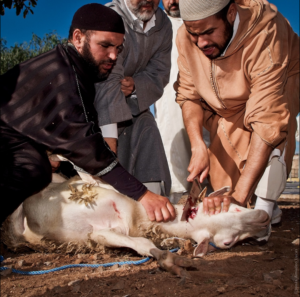
Under the Council of Europe’s Convention for the Protection of Animals for Slaughter and the EU’s Council Regulation 1099/2009, animals must be stunned or sedated in some way prior to slaughter. Both, however, allow Member States to permit derogations from the pre-stunning requirement in the case of ritual slaughter when requested by religious communities. Some do, some do not. The laws also vary in other parts of the world and it seems likely that both the dhabīḥah and shechita methods were originally supposed to be the most humane way to kill an animal you want to eat. On ‘The Conversation’ website, Professor Suzanne Rutland of the Department of Hebrew, Biblical and Jewish Studies at the University of Sidney writes that for thousands of years, the kosher method of slaughtering was believed to be the least painful. She points out that Judaism is concerned with animal welfare: “Indeed, hunting is not permitted in Jewish law, the Bible rules that animals have to rest on the seventh day as well as humans, and the Talmud states that one should feed one’s animals before one feeds oneself.”
WHEN IS PAINLESS REALLY PAINLESS?
Does stunning work? Is it enough? In the United States, where science is viewed as purely empirical and free of moral prejudices, little research has been done into whether or not ritual killing is humane. It should be pointed out that some smuggled footage of dhabīḥah and shechita slaughter being carried out in abattoirs around the world suggest it is not in every case. Much depends on the individuals involved and how committed they are to following the rules. The UK’s New Scientist magazine ran an article in 2009 looking into the practice and judged that it was not as humane as had been claimed. “Brain signals have shown that calves do appear to feel pain when slaughtered according to Jewish and Muslim religious law, strengthening the case for adapting the practices to make them more humane,” wrote Craig Johnson, who led the study at Massey University in Palmerston North, New Zealand.

Johnson anaesthetised the animals being used in the experiment before performing the rituals. “The team first cut sedated calves’ throats in a procedure matching that of Jewish and Muslim slaughter methods. They detected a pain signal lasting for up to 2 minutes after the incision. When their throats are cut, calves generally lose consciousness after 10 to 30 seconds, sometimes longer.” The researchers discovered that the pain felt by the animals originates from cutting the nerves in the throat, not from blood loss, which they believe demonstrates that severed nerves continue to send pain signals until the time of actual death. If the animals were stunned 5 seconds after the incision, however, the pain signal disappeared immediately. Johnson told New Scientist that the religious communities had assured him that animals do not experience any pain, so the results of his research may come as a surprise to them.
It comes as no real surprise to animal welfare campaigners, of course, such as the UK’s Royal Society for the Prevention of Cruelty to Animals (RSPCA). On their website they highlight a report from 2003 by the Farm Animal Welfare Council (now renamed the Farm Animal Welfare Committee), which concluded that: “The level of restraint of conscious animals required for slaughter without pre-stunning was far greater than for conventional slaughter.” And also that: “A large cut made across the neck of a conscious animal would result in very significant pain and distress before the animal loses consciousness (around 5 to 7 seconds for sheep, 22 to 40 seconds for adult cattle).”

BITING OFF MORE THAN ONE CAN CHEW
A visit to a working abattoir is a salutary experience, if seldom a pleasant one. As a journalist I have had to visit several over the years, especially during the scare over bovine spongiform encephalopathy (BSE), sometimes called ‘mad cow disease’. The bellows of fear from the cattle awaiting their turn to be slaughtered are distressing to hear but less so than the screams of pigs. They sound distressingly like small children. The slaughter and subsequent processing in abattoirs are overseen by a veterinary inspector who must be shown examples of each animal after slaughter to check that it is fit for human consumption. In one where I was filming, the severed and partially skinned head of a newly killed cow was brought to the inspector and in what was left of its neck a pulse was clearly beating. I’m sure an expert would say that it was just a reflex action, and that the beast was most certainly dead – it certainly didn’t alarm the staff in the cutting room nor the veterinary inspector – but it was, none-the-less, a disturbing thing to see.
According to the Eurogroup for Animal Welfare, most Europeans are in favour of pre-stunning, although the idea was rejected by the Advocate General of the Court of Justice of the European Union (CJEU), obliging a number of EU member states to reverse their laws restricting ritual slaughter in order to permit it to continue, albeit not for long, as we shall see. In an October 2020 Press Release, the Eurogroup said: “In stark opposition with the recent Advocate General’s opinion, EU citizens want all animals to be stunned before slaughter.” In a survey into public opinion on ritual slaughter and pre-stunning in Europe, organised by the Eurogroup, 92% of EU citizens said they would like to allow Member States to adopt additional measures to ensure higher animal welfare standards during slaughter if they wished. The survey was unequivocal in its results. 89% of respondents believed it should be mandatory to render animals unconscious before they are slaughtered. In addition, 87% wanted the EU to bring in rules to make stunning compulsory before slaughter, including before ritual slaughter, while 80% would favour the EU prioritising funding to find alternative and more humane ways to slaughter that would be acceptable to religious authorities, if such a thing is ever possible.

Of course, the wider public don’t always get everything right. Left to the people at large, for instance, would the death sentence be reintroduced for the most heinous crimes? A lot of people have indicated in surveys that they would like that. What other sorts of laws might be introduced, or what existing laws might be scrapped altogether? How many populist leaders would succeed in getting their followers to vote them into a presidency for life? There is an old saying in commerce: “the customer is always right”. A self-employed small businessman friend of mine always added to it: “the customer is always right – stupid, pig-headed, ignorant and ill-informed but right. Up to a point.” The point in question was the one at which it would impact on his profits. It could be argued, therefore, that these questions are best left to experts. But then the question arises: which experts? It’s a conundrum, and one that most political leaders have failed to solve to everyone’s satisfaction, which is why there are so many pressure groups trying to persuade them one way or another. Political centrists and the liberal-minded often seem to think that most people think like them. A Saturday evening spent talking to ordinary people in drinking establishments in the poorer areas of their less fashionable towns would soon disavow them of that belief.
MANY WAYS TO DIE
What those with strong religious beliefs would find acceptable varies greatly. As shown on the fact sheet on ritual slaughter provided by the United States Commission on International Religious Freedom (USCIRF), which reads: “animal rights activists and others contend that shechita and dhabīhah are inhumane methods of slaughter, and as a result have sought to limit the practice by requiring stunning the animal at certain points in the process or banning the practice outright.

Some countries have laws that require an animal be stunned before the cut is performed (‘pre-cut stunning’), after the cut is performed (‘post-cut stunning’), or at the same time as the cut (‘concurrent sedation’).” The USCIRF is not in favour of these restrictions: laws restricting methods of ritual slaughter could be considered as restrictions on religious freedom, they conclude. With the laws varying across the EU, it is difficult for devout Jews or Muslims to fully observe the ordinances of their respective faiths when it comes to eating. Even then, says the USCIRF, the two faiths differ in their responses to the legal restrictions. “While some Islamic authorities accept certain types of stunning in ritual slaughter, there is virtually no such allowance by Jewish authorities.”
The Council of Europe’s European Convention for the Protection of Animals for Slaughter, which dates from 1979, and the EU’s Council Regulation 1099/2009 from thirty years later, both demand stunning before slaughter, but they also authorize countries to make their own regulations concerning “slaughtering in accordance with religious rituals”. This vagueness is what has left the mish-mash of regulations across Europe. Germany, for instance, has banned slaughter without anaesthesia, but a Federal Administrative Court decision permits ritual slaughter by trained people in an accredited slaughterhouse under observation by the local veterinary inspection office.
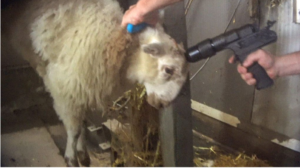
In Cyprus, the Department of Veterinary Services said they were granting exemptions to the EU Directive requiring pre-cut stunning, but the Jewish community there has complained that they do not, in fact, do so. Jews there are allowed to import kosher meat, but it costs much more, of course. There was a Joint Ministerial Decision in Greece to permit ritual slaughter according to the demands of halal and kosher principles, but it has to include stunning immediately after cutting (except for poultry) and take place in a properly licenced abattoir.
The Finnish Animal Protections Act means that stunning is required there before cutting, however it is allowed for animals to be stunned at the same moment as slaughter takes place. Islamic authorities have accepted meat produced that way as halal but Jewish community leaders refuse to regard it as kosher. Denmark banned ritual slaughter without pre-stunning but allows halal and kosher meat to be imported.
DEATH ON TRIAL
I have already mentioned the confusing case of Belgium’s federal system, where two of its three regions, Wallonia and Flanders, adopted legislation banning ritual slaughter without pre-stunning. This was challenged by the Coordinating Committee of Jewish Organisations who filed a lawsuit in the country’s Constitutional Court, which turned to the EU’s Court of Justice for advice. In the end, it upheld the bans, although ritual slaughter was allowed in any case in the Brussels region, but then that verdict was overturned by the Advocate General of the EU’s Court of Justice. It was not a verdict that found favour with the Eurogroup for Animals. “In 2020 we should not think that, as cited in the opinion, animal welfare and religion ‘often sit uneasily’, as technology and best practice are there to guarantee that both values are respected at the same time”, said Reineke Hameleers, the group’s Chief Executive. However, that was not the end of the story.

That had been just the Advocate General’s opinion, which the full Court is not obliged to follow and on this occasion it didn’t. Sitting as the Grand Chamber in December 2020, it upheld the view expressed in Regulation No. 1099/2009 that the main objective must be the protection of animals. “In order to promote animal welfare in the context of ritual slaughter,” it announced, “Member States may, without infringing the fundamental rights enshrined in the Charter, require a reversible stunning procedure which cannot result in an animal’s death.” It further clarified its findings like this: “Member States may adopt national rules aimed at ensuring more extensive protection of animals at the time of killing than those contained in Regulation No. 1099/2009 in relation to ritual slaughter.” The Belgian decree requires that all animals slaughtered for human consumption must be killed only after using proper stunning procedures to limit animal suffering and promote humane slaughtering practices. This amendment seems to removes the exceptions for religious and ritual slaughter that were originally allowed by Regulation 1099/2009.
Muslim and Jewish groups argue that this new restriction seriously infringes their rights to religious freedom of expression because they are unable to obtain meat from animals slaughtered in accordance with their beliefs, but the Court’s formal judgement leaves very little ‘wriggle-room’: “Killing animals may induce pain, distress, fear or other forms of suffering to the animals even under the best available technical conditions,” says the opening paragraph. “Certain operations related to the killing may be stressful and any stunning technique presents certain drawbacks. Business operators or any person involved in the killing of animals should take the necessary measures to avoid pain and minimise the distress and suffering of animals during the slaughtering or killing process, taking into account the best practices in the field and the methods permitted under this Regulation. Therefore, pain, distress or suffering should be considered as avoidable when business operators or any person involved in the killing of animals breach one of the requirements of this Regulation or use permitted practices without reflecting the state of the art, thereby inducing by negligence or intention, pain, distress or suffering to the animals.”
The Court of Justice’s ruling has been savaged by religious groups. Doctor Mark Goldfelder, Director of the National Jewish Advocacy Center and the founding editor of the Cambridge University Series on Law and Judaism, condemned it in no uncertain terms: “The ruling was factually wrong, legally problematic, discriminatorily hypocritical and systemically dangerous.” In an angry article on the New Europe website he repeats the claim that ritual slaughter is humane.

“Kosher ritual slaughter (shechita) requires the use of a special razor-sharp elongated blade that severs the trachea and oesophagus of the animal in one fluid motion, causing instantaneous loss of blood pressure, so that the animal feels nothing.” The research carried out in New Zealand would not appear to bear out that claim but perhaps it is something that merits further research. Whatever the outcome, though, it seems unlikely to persuade religious groups one way or the other. The Court judgement, whilst recognising the need to respect religious freedoms, is clear that animal welfare must come first. “In order to assess whether such a limitation is permissible,” it says, “the Court finds, first of all, that the interference with the freedom of manifest religion resulting from the Decree is indeed provided for by law and, moreover, respects the essence of Article 10 of the Charter (of Fundamental Rights), since it is limited to one aspect of the specific ritual act of slaughter, and that the act of slaughter is not, by contrast, prohibited as such. The Court finds that that interference meets an objective of general interest recognised by the European Union, namely the promotion of animal welfare.”
Slovenia passed its own Animal Welfare Act in 2012 under which all ritual slaughter is banned, and this was upheld in 2018 by the Constitutional Court. The country’s Islamic community provides certificates to companies producing meat from stunned animals to confirm that it is nevertheless halal in their judgement, but the Jewish community imports kosher meat from countries that produce it. The United States is not happy with Europe’s smorgasbord of regulations, which it sees as unfair to Jews and Muslims. It says it confirms their ‘outsider’ status and would prefer Europe to drop its various regulations regarding the way in which ritual slaughter requires pre-cut stunning.

A 1935 fatwa by the Mufti of Delhi declared that non-fatal stunning that is thus ‘reversible’ is allowed under Islamic law. Al-Azhar rector Muhammad el-Tayyeb el-Naggar confirmed in 1982 that stunning would not make the practice un-Islamic.
Many Muslim authorities accept reversible stunning prior to the cut, such as with electricity or a round-headed hammer, but Jewish authorities are less inclined to view the idea favourably. According to Jewish law, slaughter of cattle and poultry must be carried out with a single cut to the throat. According to ShechitaUK, all forms of mechanical stunning “which may include asphyxiation by gas, electrocution by tongs or water or shooting with a captive bolt gun, cause pain on application and are thus prohibited by Jewish law”.
ShechitaUK, all forms of mechanical stunning “which may include asphyxiation by gas, electrocution by tongs or water or shooting with a captive bolt gun, cause pain on application and are thus prohibited by Jewish law”.
It’s an incredibly delicate area for politicians and lawyers to wander into. On Oxford Academic’s ‘Animal Frontiers’ website the problem is set out clearly: “Current concerns about religious slaughter focus on stress of preslaughter handling using certain devices, pain and distress that may be felt during and after neck cutting, as well as prolonged times to loss of brain function and death if stunning is not applied.”
THE MOST UNKINDEST CUT OF ALL?
For Muslims, the correct method of slaughter is the one laid down in the Qur’an and the Hadith (the sayings and acts of Mohammed). “Prior to the act of slaughter (Al-Dhabh), pronouncing the name of God (Tasmiyya) is a requirement. Following restraint, slaughter is carried out by a transverse incision of the neck to achieve instant and copious exsanguination. Rapid and maximum blood loss is crucially important because consumption of blood is forbidden.” For Jews, the rule is similar (and, of course, much older): “A trained slaughterman, Shocet, appointed by the Shechita Board, makes a transverse cut across the neck using a sharp, special knife, the chalef. The chalaf needs to be inspected for sharpness after each cut. Preslaughter stunning and damage to tissues such as haemorrhages are not accepted. The reasons for rejecting stunning include that the original method is superior, painless, and causes instantaneous insensibility while stunning causes damage to carcasses.” After slaughter, the carcass is carefully examined by a special inspector, who looks for such defects as haemorrhages, while rejecting certain parts (treifa). The meat is then ‘porged’ (examined in order to locate and remove prohibited parts). Forbidden tissues, such as blood and various fats known as chailev are removed, as well as the sciatic nerve, which normally means the removal of the hind legs and everything behind the twelfth rib. As with Islam, the consumption of blood is forbidden as they believe God ordered them to reserve it for him. The rear part of the animal removed this way is usually sold into the general market for meat because it is difficult and tedious to ‘porge’.
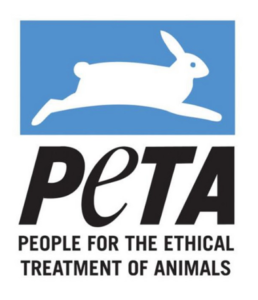
Jehovah’s Witnesses, who were persecuted by Hitler’s Nazis, along with the far more numerous Jews, Roma, Sinti and others, are also forbidden to consume an animal’s blood. So, if a Jehovah’s witness performs the slaughter, can a Muslim consider the meat halal? Well, possibly; the Irshad website is ambivalent: “With respect to their ritual sacrifice, they need to ensure that the strict conditions of slaughter are met, namely, that (1) the throat is cut with a sharp instrument whilst the animal is alive, (2) three of the four vessels (carotid arteries, trachea and oesophagus) are severed, and (3) the name of Allah is mentioned, in any language, at the time of slaughter.” So, the answer could be yes, but is probably ‘maybe’.
Another animal welfare pressure group, People for the Ethical Treatment of Animals, PETA, is unequivocal in condemning ritual slaughter, whilst admitting that at some point in time it was probably more acceptable: “The dietary laws of Islam and Judaism require that animals be ‘healthy’ at the time their throats are cut. When these laws were passed thousands of years ago, they were probably more humane than any other existing alternative. However, the world has changed drastically since then, and today, slaughter is just the final stage of a life filled with misery, pain, and fear for animals raised for their flesh on factory farms.”

It’s worth remembering that UK-based PETA is against animals being put to use by humans in any way and at any time, not just for food. “It’s a simple fact that no form of slaughter – religious or otherwise – can ever be humane,” says PETA’s website. “The sheer number of animals required to feed society’s current meat habit makes individual attention to their wants and needs impossible. In conventional abattoirs in the UK, millions of cows, pigs, sheep, and chickens are improperly stunned using captive-bolt guns, electrocution, or gassing every year, meaning that their throats are slit while they’re conscious and terrified.” In what may be a sign of wishful thinking, PETA reports that growing numbers of Muslims are turning their backs on meat and advocating kindness to animals while many Jews, they say, now believe that eating vegan is, as they put it, the new kashrut (dietary law) of our age. That may seem hard to believe but apparently veganism is growing so fast in Israel that the country has been dubbed ‘the vegan capital of the world’. Don’t forget to say mazel tov when you next raise a glass of carrot juice.
In fact, even the judgement of the Court of Justice is open to interpretation. “Animals shall only be killed after stunning in accordance with the methods and specific requirements related to the application of those methods set out in Annex I. The loss of consciousness and sensibility shall be maintained until the death of the animal.” But then it goes on to say: “In the case of animals subject to particular methods of slaughter prescribed by religious rites, the requirements of paragraph 1 shall not apply provided that the slaughter takes place in a slaughterhouse.” As the saying goes, the whole issue is as clear as mud. No amount of science is likely to persuade people where deeply held beliefs are involved. Facts and scientific proof are mutable; beliefs are very often set in stone.

